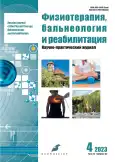The use of physiotherapeutic methods in the treatment of dry eye syndrome
- Authors: Egiazarova A.G.1, Raifeld A.K.1,2, Korchazhkina N.B.1
-
Affiliations:
- Petrovsky National Research Centre of Surgery
- M.M. Krasnov Research Institute of Eye Diseases
- Issue: Vol 22, No 4 (2023)
- Pages: 299-305
- Section: Review
- URL: https://journals.rcsi.science/1681-3456/article/view/255381
- DOI: https://doi.org/10.17816/rjpbr627392
- ID: 255381
Cite item
Abstract
The relevance of the treatment of dry eye syndrome is associated with the widespread prevalence of this disease. Along with the development of information technology and an increase in time spent in front of screens, the number of people suffering from this disease is steadily growing.
The basis of treatment for dry eye syndrome is the use of “artificial tears” preparations, which are instilled into the conjunctival cavity to replenish moisture deficiency. But the effect of tear replacement therapy in case of dysfunction of the meibomian glands does not last long. In this regard, the use of physiotherapeutic methods for treating dry eye syndrome to prolong the effect of drug therapy for this pathology is of particular importance.
Each of the methods of physiotherapeutic treatment of dry eye syndrome has its own unique mechanisms of action and indications for use. Physiotherapeutic methods are an effective tool in the treatment of dry eye syndrome, providing the opportunity to improve the quality of life of patients suffering from this common ophthalmic disease.
Full Text
##article.viewOnOriginalSite##About the authors
Agata G. Egiazarova
Petrovsky National Research Centre of Surgery
Email: agata_karolina@mail.ru
ORCID iD: 0000-0001-9959-2744
SPIN-code: 9181-2776
Russian Federation, Moscow
Alina K. Raifeld
Petrovsky National Research Centre of Surgery; M.M. Krasnov Research Institute of Eye Diseases
Author for correspondence.
Email: 9700744@mail.ru
ORCID iD: 0000-0003-2824-7155
SPIN-code: 1787-0013
MD, Cand. Sci. (Med.)
Russian Federation, Moscow; MoscowNatalya B. Korchazhkina
Petrovsky National Research Centre of Surgery
Email: n9857678103@gmail.com
ORCID iD: 0000-0002-9804-7725
SPIN-code: 9733-7646
MD, Dr. Sci. (Med.), Professor
Russian Federation, MoscowReferences
- Craig JP, Nichols KK, Akpek EK, et al. TFOS DEWS II definition and classification report. Ocul Surf. 2017;15(3):276–283. doi: 10.1016/j.jtos.2017.05.008
- Tsubota K, Yokoi N, Shimazaki J, et al.; Asia Dry Eye Society. New perspectives on dry eye definition and diagnosis: A consensus report by the Asia Dry Eye Society. Ocul Surf. 2017;15(1):65–76. doi: 10.1016/j.jtos.2016.09.003
- Sakhnov SN, Yanchenko SV, Malyshev AV, et al. Dry eye epidemiology in patients before cataract surgery. Ophthalmology. 2020;17(2):281–289. EDN: OTXEIX doi: 10.18008/1816-5095-2020-2-281-289
- Brzhesky VV, Golubev SYu, Brzheskaya IV, Popov VYu. New possibilities of tear replacement therapy in patients with dry eye syndrome of various origins. Ophthalmology. 2019;16(2):244–251. EDN: BHGCQK doi: 10.18008/1816-5095-2019-2-244-251
- Maychuk DYu, Loshkareva AO, Tsvetkova TV. The complex treatment algorithm for dry eye syndrome with meibomian gland dysfunction. combination of intense pulsed light (IPL) with eyelid hygiene and artificial tears. Ophthalmology. 2020;17(S3):640–647. EDN: GOSVNR doi: 10.18008/1816-5095-2020-3S-640-647
- Toyos R, McGill W, Briscoe D. Intense pulsed light treatment for dry eye disease due to meibomian gland dysfunction: A 3-year retrospective study. Photomed Laser Surg. 2015;33(1):41–46. doi: 10.1089/pho.2014.3819
- Trubilin VN, Poluninа EG, Kurenkov VV, et al. Therapeutic eyelids hygiene in the algorithms of prevention and treatment of ocular surface diseases. Ophthalmology. 2016;13(2):122–127. EDN: WCDCWN doi: 10.18008/1816-5095-2016-2-122-127
- Ngo W, Gann D, Nichols JJ. Impact of the 2011 International Workshop on Meibo mian gland dysfunction on clinical trial attributes for meibomian gland dysfunction. Ocul Surf. 2020;18(1):27–30. doi: 10.1016/j.jtos.2019.10.003
- Prozornaya LP, Brzhesky VV. Efficacy of physiotherapy and hygienic procedures in treatment of adults and children with chronic blepharitis and dry eye syndrome. Vestnik oftal’mologii. 2013;129(3):68–73. EDN: QYLKYJ
- Valencia-Nieto L, Novo-Diez A, Blanco-Vázquez M, López-Miguel A. Therapeutic instruments targeting meibomian gland dysfunction. Ophthalmol Ther. 2020;9(4):797–807. doi: 10.1007/s40123-020-00304-3
- Demolin L, Es-Safi M, Soyfoo MS, Motulsky E. Intense pulsed light therapy in the treatment of dry eye diseases: A systematic review and meta-analysis. J Clin Med. 2023;12(8):3039. doi: 10.3390/jcm12083039
- Schanzlin D, Owen J, Klein S, et al. Efficacy of the systane iLux thermal pulsation system for the treatment of meibomian gland dysfunction after 1 week and 1 month: A prospective study. Eye Contact Lens. 2022;48(4):155–161. doi: 10.1097/ICL.0000000000000847
- Sherstyanykh MV, Markova AYu. Clinical effectiveness of selective IPL therapy for patients with dry eye syndrome combined with dysfunction of the meibomian glands. Modern technologies in ophthalmology. 2023;(5):98–101. EDN: GBFKLR doi: 10.25276/2312-4911-2023-5-98-101
- Kalmykov RV, Kamenskikh TG. Method of treatment of dry eye syndrome against the background of dysfunction of the meibomian glands. Bulletin of Medical Internet Conferences. 2015;5(4):238. EDN: TTUCOF
- Komarova ME. Dry eye syndrome and its impact on the quality of life of patients. Science in the modern information society: Proceedings of the XXX international scientific and practical conference, Bengaluru, November 28–29, 2022. Bengaluru: Pothi.com; 2022. Р. 69–73. EDN: HCPFBE
- Popov AYu, Popova NA, Tyurin AV. Physical model of the effect of low-intensity laser radiation on biological objects. Optika i spektroskopiya. 2007;103(4):690–697. EDN: IBAOXN
- Medvedev IB, Trubilin VN, Polunina EG. Modern possibilities of physiotherapeutic treatment in meibomian gland dysfunction. Ophthalmology. 2022;19(2):235–241. EDN: UXJTPT doi: 10.18008/1816-5095-2022-2-235-241
Supplementary files







